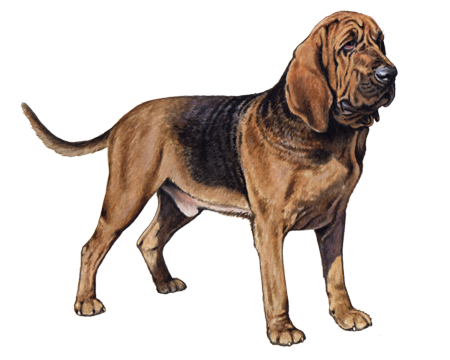
Estonian Hound
Estonian Hounds are happy, friendly dogs and energetic hunting companions. They love attention and form tight bonds with their humans—making them a devoted and affectionate addition to most families.
Interested in discovering if your dog is an Estonian Hound?
Check out Wisdom Panel's DNA tests.

Estonian Hound Traits
General Appearance
The Estonian Hound is a medium-sized dog with a strong, muscular build.
Coat and Coloring
The breed has a short, harsh, glossy coat and moderate undercoat. These dogs typically come in a tricolor pattern consisting of black patches with tan and vivid white markings.
Distinctive Physical Traits
Estonian Hounds have a moderately wide and slightly curved skull, long and straight muzzle, dark brown eyes, and thin drop ears that reach half the length of the muzzle when pulled. Their tails form a saber and are thick at the base and covered in dense hair.
Estonian Hound Temperament
Calm, friendly dogs, Estonian Hounds make excellent family pets. They're gentle and playful with kids and get along well with other dogs. (Cats, on the other hand, take a little getting used to.)
Though they are energetic hunting partners, Estonian Hounds also have a laid-back side. Cuddle sessions on the couch? Sign them up. As long as they get to spend time with their humans, they're happy.
These pups love to follow a scent trail—which is great for hunting but not so great for outings with the family. It's best to keep your dog on a leash when outdoors to prevent them from wandering off.


Estonian Hound History
The Estonian Hound is a newer breed and the only one developed in Estonia.
In 1947, the Soviet Union's Ministry of Agriculture and Economy declared that every country in the union must have its own dog breed. But not just any dog breed would do. They wanted to replace the large hunting dogs of the day with smaller, more agile ones less likely to endanger Estonia's shrinking wildlife population. So, people crossed local hunting dogs with Beagles and various hounds.
In 1954, the Ministry approved the breed standard for the Estonian Hound. After Estonia regained its independence, it declared the breed its national dog. And it remains extremely popular among both hunters and families there today.
Estonian Hound Care
Nutrition
Estonian Hounds thrive on a high-quality diet formulated for their life stage (e.g., puppy, adult, senior). Foods created specifically for medium-breed dogs are also a great option to consider.
To help your dog maintain a healthy weight, measure their portions to avoid overfeeding, and keep an eye on how many treats you're giving them. As a guideline, treats should make up no more than 10% of a dog's daily calories.
Grooming
Estonian Hounds are moderate shedders and require weekly brushing to remove loose fur—as well as an occasional bath to keep them clean and tidy. To reduce the chance of infections, check your pup's ears regularly and clean them as needed to remove wax build-up and debris.
Nail trims should also be part of every dog's grooming routine. If your Estonian Hound's nails grow too long, they can cause pain and potentially lead to problems running or walking.
Lastly, good dental hygiene will support your dog's overall health. Dental disease is one of the most common health conditions in adult dogs. Left untreated, it can contribute to other serious issues. In addition to professional cleanings, establish an at-home dental care program that includes regular teeth brushing and veterinarian-recommended dental chews.
Exercise
Estonian Hounds are energetic pups that need at least an hour of exercise a day. They enjoy long walks and hikes and love the chance to run around in large, fenced areas. They're also well-suited for dog sports—such as agility, scent tracking, rally, and competitive obedience.
Training
These intelligent, eager-to-please dogs are typically easy to train. A consistent approach and positive reinforcement using treats or favorite toys as rewards work well for this breed.
Additionally, Estonian Hounds benefit from early socialization. Getting your pup comfortable with different people and environments when they're young will help them develop into a confident, well-mannered adult dog.

Breed Group
Hound
The most common ancestral trait of this group is being used for hunting. Some use acute powers of scent to follow a trail while others demonstrate the gift of stamina as they run down a quarry. Beyond these two common traits, however, generalizations about hounds are hard to come by as the group is comprised of a very diverse lot of breeds.
Resources
https://www.petpaw.com.au/breeds/estonian-hound/#tab-id-5
http://www.fci.be/Nomenclature/Standards/366g06-en.pdf
Reviewed June 16, 2021 by Annette Louviere, DVM


































